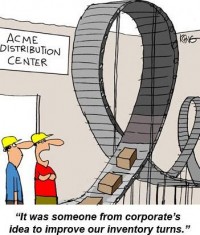How to Solve Cash Flow Problems: Inventory Turn
Effectively managing inventory is critical when asking “How do I solve my small business cash flow problems?” In many respects inventory is like cash. Sell the inventory and you have cash (once the accounts receivable is paid). Having too much inventory in the warehouse or having inventory that is not selling, is going to have a major impact on cash flow, as you have spent money buying the inventory, but it is sitting there doing nothing. If it is not selling, it is as good as wasted cash!
So, how to solve cash flow problems? Focus on actively managing your inventory turns.
In accounting terms, we have a little formula called the ‘Inventory Turn’ which helps businesses to effectively manage their cash flow. The Inventory Turn formula is calculated as:
Inventory Turn = Cost of Goods Sold / Average Inventory
Average Inventory = Beginning Inventory + Ending Inventory / 2
Inventory Turns can be worked out for any period – a year, six months, quarter etc. Whatever suits the business. Often it is helpful to calculate multi-period Inventory Turns to ensure the result is consistent across a longer period.
Let’s look at an example. If the cost of goods sold for a year is $200,000 and the average inventory is £50,000 then the Inventory Turn is 4, which means the inventory is ‘turning over’ or being sold, on average 4 times per year over every 91.25 days (worked out by dividing 4 by 365 days in the year).
Inventory Turns differ in industries, so it is important to look at what the industry norms are for your industry. Perhaps you accountant might be able to assist you in providing that information. Equally, industry associations often hold that type of information.
So how does Inventory Turn help to answer the question, ““How do I solve my small business cash flow problems?”
As I mentioned earlier, if you have a lot of inventory sitting and not being sold, that is effectively wasted cash or dead cash, as you have paid for the inventory. It is important to be turning your inventory as often as is suitable for your industry. Whereas a high inventory turn might be suitable in the grocery trade, it will be low in the luxury car market, for example.
Also, it pays to look at the composition of what stock is selling and what is not, as the ‘devil is in the detail’. Some inventory may be turning over quickly, whereas other stock may not. It is important to look beyond the numbers to actually see what stock is selling.
Slow moving stock may be obsolete or damaged, and therefore chewing up cash. In that instance, it is best to ‘fire sell’ it if possible to release the cash, rather than throwing the inventory away at some future time.
If you would like to learn more on how to address the cash flow issues in your business, then please go to www.adelemclay.com/free-resources and download my SPEARHead System™ – 50 Strategies For Supercharged Small Business Cash Flow.
Could some guidance from me be helpful to you? If so, please arrange a free 30 mins Skype strategy meeting with me. Here’s my calendar to book a meeting. I’d love to support you in some way to gain ‘seductive clarity’ in any aspect of your business or life.
Other articles on Small Business Cash Flow:
Small Business Cash Flow – The Ultimate Guide
Cash Flow Problems in YOUR Small Business
Small Business Cash Flow Problems
Cash Flow in Business
Cash Flow Projections – Important in Business?
Projected Cash Flow – Relevant in Business?
Small Business Problems: Why are YOU in Business?







